Atomistic Simulation of Microstructural Evolution of Ni50.8Ti Wires during Torsion Deformation
Abstract
:1. Introduction
2. Methodology
3. Results and Discussion
3.1. Evolution of Grain Morphology
3.2. Martensitic Transformation
3.3. Evolution of Dislocation
4. Conclusions
- (1)
- The grains were rotated and elongated to form long strips of grains. When the simulation time increased, the amount of deformation increased, and part of the elongated grains were split, forming smaller grains. Stress-induced martensitic transformation took place during the torsion simulation, resulting in the formation of 30% austenites and 50% martensites.
- (2)
- A number of dislocations were produced during the torsion simulation, and the average dislocation density reached the same order of magnitude that was generated in the metals following severe deformation. With a small amount of torsion deformation, the main plastic deformation mechanism was dislocation movement. With a large amount of torsion deformation, the main mechanism was grain rotation.
- (3)
- Although the model size and simulated torsion speed were different from the parameter ranges of the actual torsion tests, they could still predict the microstructural evolution of the NiTi alloy during the torsion deformation process, which is more conducive to understanding the evolution law of different models with various grain sizes during torsion deformation. It is hoped that an MD model closer to real-life dimensions could be established using real-life parameter settings in the future, which will mainly rely on the computer software/hardware equipment available and its calculation efficiency.
Author Contributions
Funding
Data Availability Statement
Conflicts of Interest
References
- Mao, Z.; Xu, Z.; Wang, Q. Shape memory alloy actuator with active cooling device and deflectable winglet application. Smart Mater. Struct. 2020, 29, 105026. [Google Scholar] [CrossRef]
- Karna, P.; Prabu, S.; Karthikeyan, S.C.; Mithun, R.; Palani, I.A. Investigations on laser actuation and life cycle characteristics of NiTi shape memory alloy bimorph for non-contact functional applications. Sens. Actuators A Phys. 2020, 321, 112411. [Google Scholar] [CrossRef]
- Barbarino, S.; Pecora, R.; Lecce, L.; Concilio, A.; Ameduri, S.; De Rosa, L. Airfoil Structural Morphing Based on S.M.A. Actuator Series: Numerical and Experimental Studies. J. Intell. Mater. Syst. Struct. 2011, 22, 987–1004. [Google Scholar] [CrossRef]
- Zhu, J.; Zeng, Q.; Fu, T. An updated review on TiNi alloy for biomedical applications. Corros. Rev. 2019, 37, 539–552. [Google Scholar] [CrossRef]
- Kim, H.Y.; Ikehara, Y.; Kim, J.I.; Hosoda, H.; Miyazaki, S. Martensitic transformation, shape memory effect and superelasticity of Ti–Nb binary alloys. Acta Mater. 2006, 54, 2419–2429. [Google Scholar] [CrossRef]
- Zhao, T.; Kang, G. Experimental study and life prediction on fatigue failure of NiTi shape memory alloy under multi-axial one-way shape memory cyclic loadings. Int. J. Fatigue 2022, 155, 106609. [Google Scholar] [CrossRef]
- Otsuka, K.; Ren, X. Physical metallurgy of Ti–Ni-based shape memory alloys. Prog. Mater. Sci. 2005, 50, 511–678. [Google Scholar] [CrossRef]
- Lim, Y.G.; Han, S.H.; Choi, E.; Kim, W.J. Shape memory and superelasticity of nanograined Ti-51.2 at.% Ni alloy processed by severe plastic deformation via high-ratio differential speed rolling. Mater. Charact. 2018, 145, 284–293. [Google Scholar] [CrossRef]
- Liu, S.; Lin, Y.; Wang, G.; Wang, X. Effect of varisized Ni4Ti3 precipitate on the phase transformation behavior and functional stability of Ti-50.8 at.% Ni alloys. Mater. Charact. 2021, 172, 110832. [Google Scholar] [CrossRef]
- Liu, S.; Zhu, J.; Lin, X.; Wang, X.; Wang, G. Coupling effect of stretch-bending deformation and electric pulse treatment on phase transformation behavior and superelasticity of a Ti-50.8at.% Ni alloy. Mater. Sci. Eng. A 2020, 799, 140164. [Google Scholar] [CrossRef]
- Li, X.; Chen, H.; Guo, W.; Guan, Y.; Wang, X. Improved superelastic stability of NiTi shape memory alloys through surface nano-crystallization followed by low temperature aging treatment. Intermetallics 2021, 131, 107114. [Google Scholar] [CrossRef]
- Wang, X.; Kustov, S.; Li, K.; Schryvers, D.; Verlinden, B.; Humbeeck, J.V. Effect of nanoprecipitates on the transformation behavior and functional properties of a Ti–50.8 at.% Ni alloy with micron-sized grains. Acta Mater. 2015, 82, 224–233. [Google Scholar] [CrossRef]
- Derakhshandeh, M.R.; Farvizi, M.; Javaheri, M. Effects of high-pressure torsion treatment on the microstructural aspects and electrochemical behaviour of austenitic NiTi shape memory alloy. J. Solid State Electrochem. 2020, 25, 279–290. [Google Scholar] [CrossRef]
- Yanqiu, Z.; Shuyong, J. The Mechanism of Inhomogeneous Grain Refinement in a NiTiFe Shape Memory Alloy Subjected to Single-Pass Equal-Channel Angular Extrusion. Metals 2017, 7, 400. [Google Scholar]
- Zhang, Y.; Jiang, S.; Tang, M.; Yan, B.; Zhao, C. Mechanisms for influence of post-deformation annealing on microstructure of NiTiFe shape memory alloy processed by local canning compression. J. Mater. Processing Technol. 2020, 291, 116998. [Google Scholar] [CrossRef]
- Liu, S.; Zhu, J.; Lin, Y.; Wang, G.; Wang, X. Effect of stretching-bending deformation and aging treatment on phase transformation behavior and superelasticity of Ti-50.8 at.% Ni alloy. Intermetallics 2021, 129, 107051. [Google Scholar] [CrossRef]
- Wang, T.; Ma, Z.; Rao, X.; Ren, Y.; Liu, Y.; Yu, K.; Cui, L. Temperature-dependence of superelastic stress in nanocrystalline NiTi with complete transformation capability. Intermetallics 2020, 127, 106970. [Google Scholar] [CrossRef]
- Wang, B.; Kang, G.; Yu, C.; Gu, B.; Yuan, W. Molecular dynamics simulations on one-way shape memory effect of nanocrystalline NiTi shape memory alloy and its cyclic degeneration. Int. J. Mech. Sci. 2021, 211, 106777. [Google Scholar] [CrossRef]
- Choi, W.S.; Pang, E.L.; Ko, W.S.; Jun, H.; Choi, P.P. Orientation-dependent plastic deformation mechanisms and competition with stress-induced phase transformation in microscale NiTi. Acta Mater. 2021, 208, 116731. [Google Scholar] [CrossRef]
- Phule, P.P. Essentials of Material Science and Engineering; Cengage Learning: Boston, MA, USA, 2009. [Google Scholar]
- Wang, B.; Kang, G.; Wu, W.; Zhou, K.; Kan, Q.; Yu, C. Molecular dynamics simulations on nanocrystalline super-elastic NiTi shape memory alloy by addressing transformation ratchetting and its atomic mechanism. Int. J. Plast. 2020, 125, 374–394. [Google Scholar] [CrossRef]
- Zhang, Y.; Jiang, S.; Wang, M. Atomistic investigation on superelasticity of NiTi shape memory alloy with complex microstructures based on molecular dynamics simulation. Int. J. Plast. 2020, 125, 27–51. [Google Scholar] [CrossRef]
- Liu, S.; Lin, Y.; Han, L.; Wang, X.; Zhao, G.; Wang, G. Atomistic simulation of microstructure evolution of NiTi single crystals in bending deformation. Comput. Mater. Sci. 2021, 199, 110733. [Google Scholar] [CrossRef]
- Song, Z.; Tang, X.; Chen, X.; Fu, T.; Zheng, H.; Lu, S. Nano-indentation and nano-scratching of pure nickel and NiTi shape memory alloy thin films: An atomic-scale simulation. Thin Solid Film. 2021, 736, 138906. [Google Scholar] [CrossRef]
- Ko, W.S.; Choi, W.S.; Xu, G.; Choi, P.P.; Ikeda, Y.; Grabowski, B. Dissecting functional degradation in NiTi shape memory alloys containing amorphous regions via atomistic simulations. Acta Mater. 2021, 202, 331–349. [Google Scholar] [CrossRef]
- Wu, Z.; Chen, X.; Fu, T.; Zheng, H.; Zhao, Y. Molecular Dynamics Investigation of the Influence of Voids on the Impact Mechanical Behavior of NiTi Shape-Memory Alloy. Materials 2021, 14, 4020. [Google Scholar] [CrossRef]
- Racek, J.; Duchon, J.; Vronka, M.; Cieslar, M. TEM observation of twins in surface grains of superelastic NiTi wire after cyclic loading. Mater. Sci. Eng. A 2020, 782, 139271. [Google Scholar] [CrossRef]
- Sun, D.; Jiang, S.; Zhang, Y.; Yan, B.; Yu, J. Influence of annealing on incomplete detwinning and deformation twinning in equiatomic NiTi shape memory alloy undergoing severe plastic deformation. J. Alloy. Compd. 2021, 871, 159550. [Google Scholar] [CrossRef]
- Ko, W.S.; Grabowski, B.; Neugebauer, J. Development and application of a Ni-Ti interatomic potential with high predictive accuracy of the martensitic phase transition. Phys. Rev. B 2015, 92, 134107.1–134107.22. [Google Scholar] [CrossRef] [Green Version]
- Lu, H.Y.; Chen, C.H.; Tsou, N.T. The Analysis of Superelasticity and Microstructural Evolution in NiTi Single Crystals by Molecular Dynamics. Materials 2018, 12, 57. [Google Scholar] [CrossRef] [Green Version]
- Li, B.; Shen, Y.; An, Q. Structural origin of reversible martensitic transformation and reversible twinning in NiTi shape memory alloy. Acta Mater. 2020, 199, 240–252. [Google Scholar] [CrossRef]
- Tyc, O.; Molnarova, O.; Sittner, P. Effect of microstructure on fatigue of superelastic NiTi wires. Int. J. Fatigue 2021, 152, 106400. [Google Scholar] [CrossRef]
- Yan, B.; Jiang, S.; Sun, D.; Wang, M.; Yu, J.; Zhang, Y. Martensite twin formation and mechanical properties of B2 austenite NiTi shape memory alloy undergoing severe plastic deformation and subsequent annealing. Mater. Charact. 2021, 178, 111273. [Google Scholar] [CrossRef]
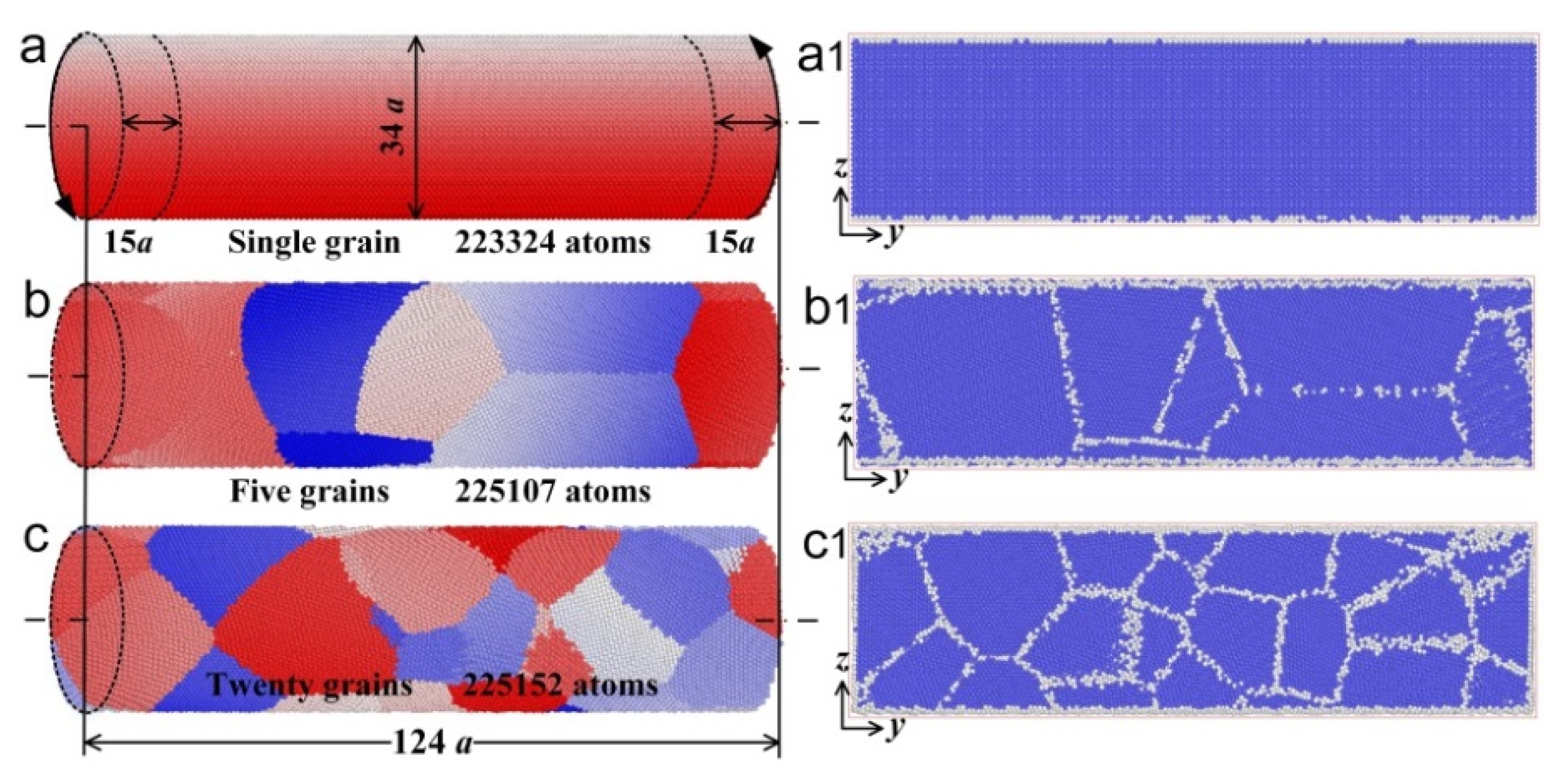

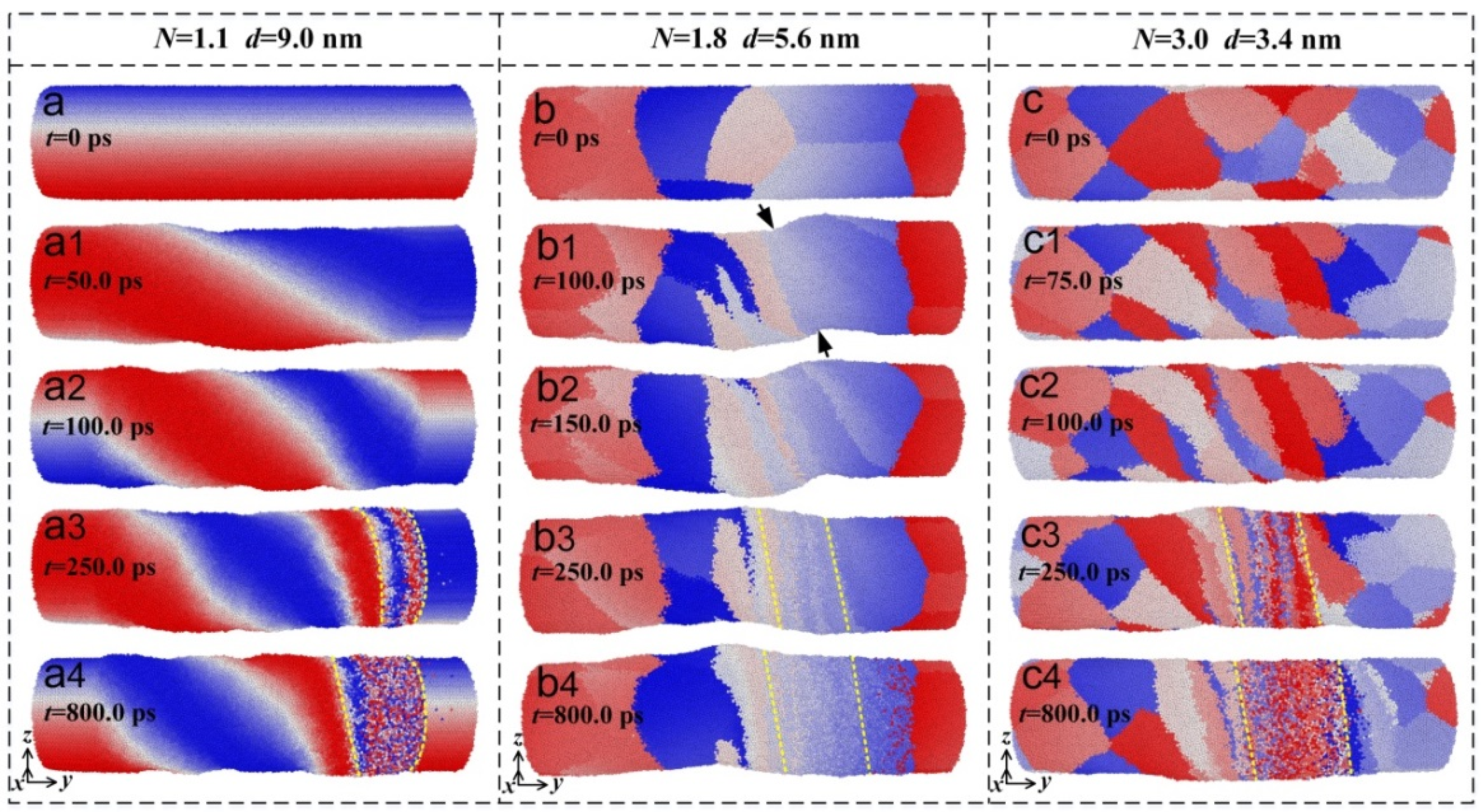

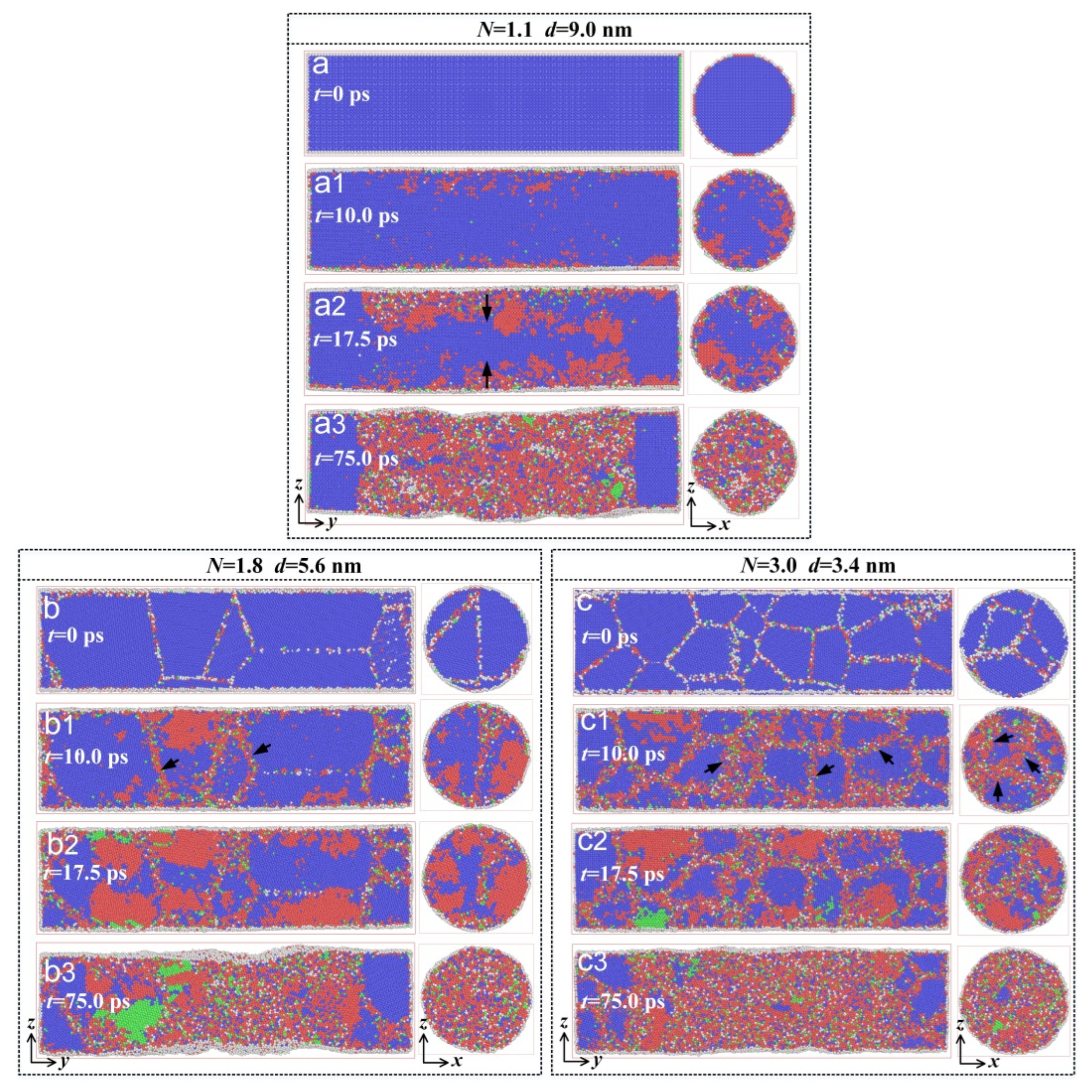

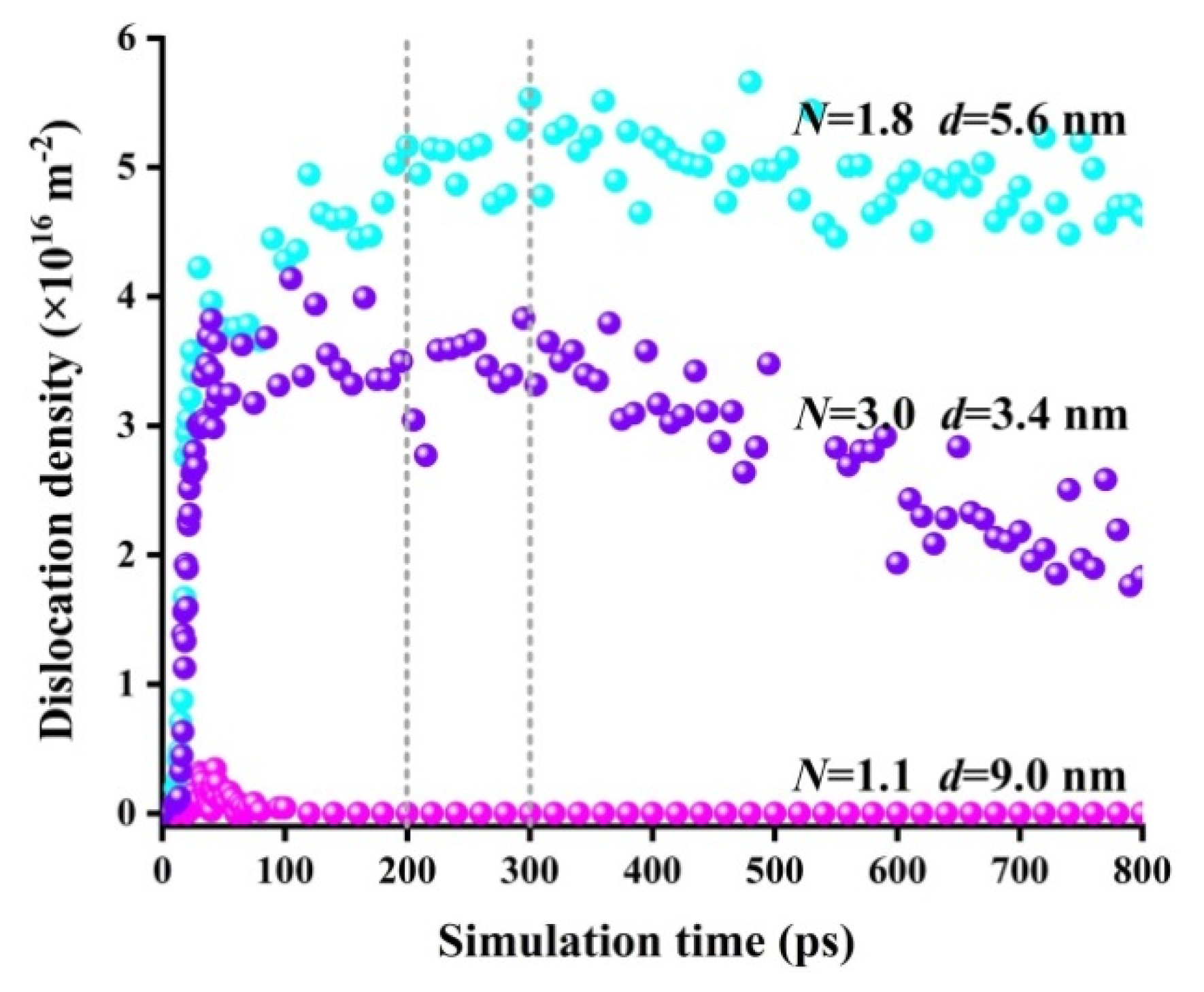
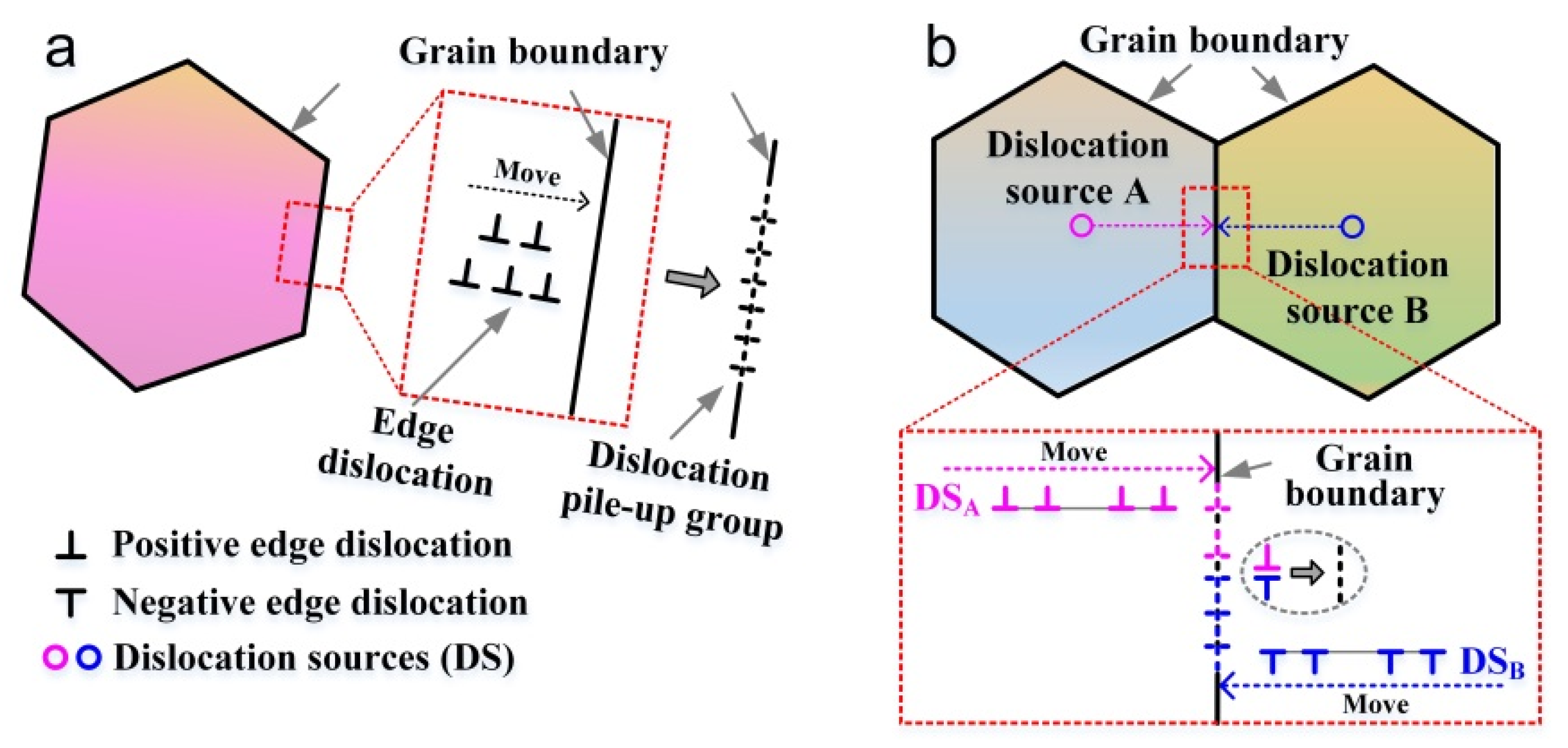
| Element | Main Composition | Impurity Composition | |||||||
|---|---|---|---|---|---|---|---|---|---|
| Ti | Ni | C | N | O | H | Co | Cu | Cr | |
| wt.% | Remainder | 55.88 | 0.012 | 0.002 | 0.040 | 0.001 | <0.046 | ||
| at.% | Remainder | 50.8 | 0.05 | 0.008 | 0.130 | 0.053 | <0.045 | ||
| Number of Grains | 1 | 5 | 20 |
|---|---|---|---|
| Diameter of model D: (nm) | 10.1966 | ||
| Average grain size d: (nm) | 9.0 | 5.6 | 3.4 |
| N = D/d | 1.1 | 1.8 | 3.0 |
Publisher’s Note: MDPI stays neutral with regard to jurisdictional claims in published maps and institutional affiliations. |
© 2021 by the authors. Licensee MDPI, Basel, Switzerland. This article is an open access article distributed under the terms and conditions of the Creative Commons Attribution (CC BY) license (https://creativecommons.org/licenses/by/4.0/).
Share and Cite
Liu, S.; Lin, Y.; Wu, T.; Wang, G. Atomistic Simulation of Microstructural Evolution of Ni50.8Ti Wires during Torsion Deformation. Materials 2022, 15, 92. https://doi.org/10.3390/ma15010092
Liu S, Lin Y, Wu T, Wang G. Atomistic Simulation of Microstructural Evolution of Ni50.8Ti Wires during Torsion Deformation. Materials. 2022; 15(1):92. https://doi.org/10.3390/ma15010092
Chicago/Turabian StyleLiu, Shan, Yao Lin, Tao Wu, and Guangchun Wang. 2022. "Atomistic Simulation of Microstructural Evolution of Ni50.8Ti Wires during Torsion Deformation" Materials 15, no. 1: 92. https://doi.org/10.3390/ma15010092
APA StyleLiu, S., Lin, Y., Wu, T., & Wang, G. (2022). Atomistic Simulation of Microstructural Evolution of Ni50.8Ti Wires during Torsion Deformation. Materials, 15(1), 92. https://doi.org/10.3390/ma15010092





